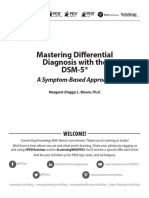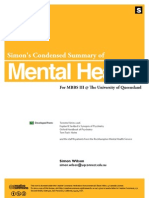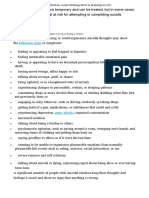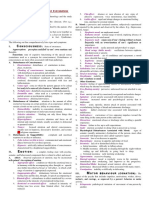Do A Client Map
Do A Client Map
Uploaded by
api-253782185Copyright:
Available Formats
Do A Client Map
Do A Client Map
Uploaded by
api-253782185Original Title
Copyright
Available Formats
Share this document
Read this document in other languages
Did you find this document useful?
Is this content inappropriate?
Copyright:
Available Formats
Do A Client Map
Do A Client Map
Uploaded by
api-253782185Copyright:
Available Formats
Sean Sandag
CNS 770
Client Map Treatment Plan
Winifred
Diagnosis
300.02 Generalized Anxiety Disorder, excessive worry more days than not (especially
about school), lasting more than 6 months, possibly with social anxiety disorder.
Rule out anxiety disorder due to another medical condition.
Rule out substance/medication-induced anxiety disorder.
Rule out posttraumatic stress disorder.
Rule out depressive, bipolar, and psychotic disorders.
Rule out body dimorphic disorder.
Rule out separation anxiety disorder.
Consider unipolar depressive disorder.
Objectives
Reduce current anxiety and worry symptoms.
Reduce stress.
Address automatic thoughts and behaviors.
Reduce frequency of absences and leaving school early.
Address use medications.
Address substance use.
Address relationships at school and home.
Address possible depressive symptoms.
Address possible past traumatic events.
Teach relaxation techniques and ways to cope.
Refer to community mental health practitioner with ability to prescribe medication.
Discuss benefits of counseling concurrent with medication to treat disorder.
Assessment
Summary- 14-year-old female initially visited Student Services reporting inability to deal
with stress. She called her mom in the bathroom to pick her up from school. Her mom
refused and the student broke down in tears feeling unable to return to class. She
complains of feeling tense, worried, and unable to concentrate in class. She sleeps in
many of her classes and has consistently called home to leave school. There is no known
past diagnosis of anxiety or depression in the familys medical history. The student is not
currently prescribed any medication. There is no other past mental health diagnosis.
Students family is comprised of her mom, dad, and younger sister (age 11).
Discuss overall lifestyle and sleeping patterns.
Discuss previous attempts to manage anxiety.
Attain parental permission to administer assessments.
Administer Penn State Worry Questionnaire.
Administer Beck Anxiety Inventory.
Consider administering PHQ-9 to assess comorbid disorder of depression.
Benefits of assessment instruments: Assessments stated are very brief and easily
attainable. A client already feeling fatigued is less likely to show resistance to these
assessments (15 questions compared to tests consisting of hundreds of questions). The
questions have potential for discussion of important information.
Refer to physician for medical evaluation to rule out medical conditions that could
explain irritability and fatigue.
Clinician Characteristics
Continue to build rapport through empathy, unconditional positive regard, and
genuineness.
Be consistent. Keep appointments and follow through with agreements.
Use elicit, provide, elicit model to provide information to client that might normalize
the disorder.
Consider brief self-disclosure of personal experience with anxiety.
Acquire various techniques for coping with anxiety.
Maintain positive attitude.
Exhibit collaborative effort, we are in this together attitude.
Never give up.
Location of Treatment
See student in counselors office in Student Services during non-core classes.
Interventions to be used
Relaxation techniques such as deep breathing, guided imagery, and muscle relaxation.
Client is more likely to experience anxiety symptoms when physiologically aroused
(Leahy, Holland, Stephen, McGinn, Lata,. 2011). Controlling physiological symptoms
could reduce anxious thoughts.
Mindfulness training- client can recognize anxious or automatic thoughts as just
thoughts (Leahy, Holland, Stephen, McGinn, Lata,. 2011).
Cognitive-behavioral therapy- 6 to 8 sessions- analysis and modification of cognitive
distortions (Seligman and Reichenburg, 2012). Enable client to look at anxious thoughts
in a different way. CBT teaches clients skills to overcome deficits in emotional and
cognitive processing and can use them in forms of exposure exercises (Fresco, Mennin,
Heimburg, and Ritter, 2013).
Consider Emotion Regulation Therapy. Consists of four phases: Phase I: Awareness
Skills Training, Phase II: Regulation Skills Training, Phase III: Experiential Exposure to
Promote New Contextual Learning, Phase IV: Consolidating Themes and Looking Ahead.
ERT focusses on motivational dysfunction while expanded emotional regulation skills
(Fresco, Mennin, Heimburg, and Ritter, 2013). This may provide the student with skills
needed to function at school and control emotions to avoid break downs or the need to
sign-out of school. ERT implements aspects of CBT, Affective Therapy, Acceptance and
Commitment Therapy (ACT), and Behavior Therapy which were all discussed by
Seligman and Reichenburg (2012).
Continue supportive therapy- maintains rapport; builds trust.
Emphasis of Treatment
Focus on strengths- what has the client been doing to effectively manage anxiety?
Supportive- show empathy and desire to understand.
Collaborative- the client and counselor work together to develop plans. Ultimately, the
client knows what is best in terms of what is working for her. Focus on what she is doing
now and what she can plan in the future.
Moderately Directive- Socratic questioning to help dispute cognitive distortions.
Focus on thoughts and behaviors.
Numbers
Individual therapy primarily
Consider needs assessment to identify other students in school that may be suffering from
anxiety. Consult with teachers and administration. If others are identified, group therapy
may be efficacious by normalizing condition. The client may feel supported in knowing
she is not alone.
Consult with family. Psychoeducational family therapy may be helpful to develop
understanding.
Timing
Moderate pace- Meet weekly during school hours based on availability of school
schedule. Utilize availability of teacher assistant period and time during non-core class.
Due to block scheduling (1 hour and 30 minute class period), client may be able to meet
up to 50 minutes (depending whether the client will meet during a teacher assistant
period). Client may be able to meet last 30 minutes of non-core class depending on
curriculum.
Meet for at least 9 weeks (1 intake session and 6-8 CBT sessions). Extend duration if
group therapy is found feasible.
Continue maintenance bi-monthly or as client needs.
Medications needed
Consider referring to outside mental health practitioner for use of SSRI if comorbid
symptoms of depression are indicated (Baldwin, Khalil, Ajel, & Garner, 2008). Monitor
suicidal ideation if SSRI is prescribed.
Benzodiazepines may be helpful for short-term use (Baldwin, Khalil, Ajel, & Garner,
2008).
Do not consider medication unless anxiety is severe.
Adjunct Services
Exercise and yoga- Although limited research has proven the efficacy of exercise and
yoga to treat anxiety disorders, positive results have shown these activities as superior to
placebos (Saeed, Antonacci, and Bloch, 2010). This may serve the client as a way to
acquire energy and manage stressors in a healthy manner.
Consult with teachers to provide her with passes to leave class and come to Student
Services when she is unable to cope with anxiety symptoms.
Planned pleasurable activities- reserve at least an hour a day to do something the client
enjoys.
Prognosis
I would tell the parents of the child that I am completely confident the student will be
able to mitigate the symptoms of her diagnosis. There is substantial empirical evidence
that shows the efficacy of CBT in treating Generalized Anxiety Disorder. The student has
many strengths. She has the support of her family, teachers, and counselor. Having
support and knowing people care has also shown to have therapeutic benefits. I would
commend her for seeking help because evidence shows that many people with GAD fail
to treat their diagnosis. I believe she will gain invaluable skills through therapy that will
be beneficial to her development, especially at her age. The diagnosis becomes more
complicated if she has a comorbid disorder of depression. This may extend time of
treatment, but the diagnosis is still completely curable. She could see some relief of
symptoms as early as two weeks through therapy, medication, or a combination of both.
References
Leahy, Robert L., Holland, Stephen J. F., & McGinn, Lata K. (2011). Treatment Plans and
Interventions for Depression and Anxiety Disorders (2
nd
edition). New York: Guilford
Publications. Retrieved from http://www.eblib.com
Seligman, L., & Reichenburg, L.W. (2012). Selecting Effective Treatments- A Comprehensive,
Systematic Guide to Treating Mental Health Disorders (4
th
edition). Hoboken, NJ: John
Wiley & Sons, Inc.
Fresco, D., Mennin D., Heimburg, R., Ritter, M. (2013). Emotion Regulation Therapy for
Generalized Anxiety Disorder. Cognitive and Behavioral Practice, 20(3) 282-300.
Baldwin, D., Ajel, K., Garner, M., (2008). Anxiety Disorder. Medicine, 36(8) 415-421.
Saeed, S., Antonacci, D., Bloch, R., (2010). Exercise, Yoga, and Meditation for Depressive and
Anxiety Disorders. American Family Physician 81(8) 981.
You might also like
- Social Work Theories Cheat Sheet For ASWB ExamDocument9 pagesSocial Work Theories Cheat Sheet For ASWB ExamMichaela HamiltonNo ratings yet
- Sample Treatment Plan Anxiety: DefinitionsDocument4 pagesSample Treatment Plan Anxiety: DefinitionsSheryl Diosto100% (2)
- Sample Case Conceptualization & Treatment SummaryDocument7 pagesSample Case Conceptualization & Treatment SummaryJoshua Gonsher86% (7)
- Substance Abuse Prevention and Control: Progress Note (Soap Format)Document4 pagesSubstance Abuse Prevention and Control: Progress Note (Soap Format)Odaa Bultum100% (1)
- All Instruments On NCMHCE Exam (77 Terms)Document8 pagesAll Instruments On NCMHCE Exam (77 Terms)Ashley Micheals100% (1)
- Treatment Plan Adolescent Self EsteemDocument2 pagesTreatment Plan Adolescent Self EsteemSophie25771% (7)
- Adult Standard Biopsychosocial TemplateDocument11 pagesAdult Standard Biopsychosocial Templateapi-404660807No ratings yet
- Manual Mastering Differential Diagnosis dsm5Document51 pagesManual Mastering Differential Diagnosis dsm5Renato FonsecaNo ratings yet
- Sample Mental Health Treatment PlanDocument3 pagesSample Mental Health Treatment PlanCordelia Kpaduwa100% (4)
- Treatment Plan TemplatesDocument2 pagesTreatment Plan TemplatesShalini Dass80% (5)
- Mental Health NotesDocument21 pagesMental Health Notesbazahoor98% (41)
- Counseling SOAP Note Depression Anxiety SampleDocument2 pagesCounseling SOAP Note Depression Anxiety SampleCordelia Kpaduwa100% (1)
- Full Anxiety Treatment PlanDocument15 pagesFull Anxiety Treatment PlanDoneil Jones100% (3)
- Do A Client MapDocument1 pageDo A Client Mapapi-420206789No ratings yet
- Treatment PlanDocument6 pagesTreatment PlanAerin100% (2)
- Psychotherapy Progress NoteDocument1 pagePsychotherapy Progress NoteArmaan Malik100% (2)
- Sample Treatment Plan With Goals For Anxiety and DepressionDocument3 pagesSample Treatment Plan With Goals For Anxiety and Depressionapi-310813184100% (2)
- Sample Treatment Plan With Goals For Anxiety and DepressionDocument3 pagesSample Treatment Plan With Goals For Anxiety and Depressionمودة عثمان100% (1)
- Adult Standard Biopsychosocial TemplateDocument10 pagesAdult Standard Biopsychosocial TemplateMistor Dupois Williams100% (4)
- Example Dap NoteDocument5 pagesExample Dap NoteLindsey Jo Townsend80% (5)
- Psychotherapy: Pune Uni SybaDocument3 pagesPsychotherapy: Pune Uni SybaPrathamananta50% (4)
- 1001 Biopsychosocial Assessment (PIHP) (Handwritten)Document26 pages1001 Biopsychosocial Assessment (PIHP) (Handwritten)Sharon Price-James100% (3)
- Mental Status Exam Template 06Document1 pageMental Status Exam Template 06KISHORE S 2037415No ratings yet
- Treatment PlanDocument7 pagesTreatment PlanN. Vent100% (5)
- Sample Progress Note Only : Functional Family TherapyDocument5 pagesSample Progress Note Only : Functional Family Therapynure85100% (2)
- Psychotherapy Notes Sample GeriatricDocument2 pagesPsychotherapy Notes Sample GeriatricKadek Mardika0% (3)
- Sample Psychotherapy NoteDocument2 pagesSample Psychotherapy NoteRafael Sanchez100% (3)
- Goals of TherapyDocument4 pagesGoals of TherapyMuneebah Abdullah0% (1)
- Psychotherapy DAP NoteDocument2 pagesPsychotherapy DAP NoteMistor Williams100% (2)
- HIP Sample Psychotherapy Progress NoteDocument23 pagesHIP Sample Psychotherapy Progress NoteALELE VINCENT100% (7)
- Sample Case Formulation - Major Depressive DisorderDocument8 pagesSample Case Formulation - Major Depressive DisorderCherry Mae TorresNo ratings yet
- Treatment Plan For DepressionDocument2 pagesTreatment Plan For DepressionvvvNo ratings yet
- Progress Notes and Psychotherapy NotesDocument4 pagesProgress Notes and Psychotherapy Notesnure8575% (4)
- Depressive Disorders Social Isolation/Impaired Social InteractionDocument5 pagesDepressive Disorders Social Isolation/Impaired Social InteractionYannesa S. Bantilan - Balbin100% (2)
- Treatment Planning Ideas FinalDocument9 pagesTreatment Planning Ideas Finaldaringdreu100% (3)
- Clinical Intake and MSEDocument5 pagesClinical Intake and MSEkashish behl100% (1)
- Mental Status ExamDocument10 pagesMental Status ExamSrini Voru100% (1)
- Sample Intake PaperDocument5 pagesSample Intake PaperSinthia RahmanNo ratings yet
- Treatment Plan ExampleDocument8 pagesTreatment Plan Exampleapi-430075910No ratings yet
- Cassie Jewell, M.Ed., LPC, Lsatp: © Mindremakeproject 2020Document1 pageCassie Jewell, M.Ed., LPC, Lsatp: © Mindremakeproject 2020Kitty G K'nkoNo ratings yet
- Case Conceptualization PaperDocument14 pagesCase Conceptualization Paperapi-554055276100% (2)
- Biopsychosocial Assessment Format2Document3 pagesBiopsychosocial Assessment Format2Hassan Maqsood100% (2)
- DAP NotesDocument1 pageDAP NotesBao KhanhNo ratings yet
- Birp CHKLSTDocument1 pageBirp CHKLSTDe BNo ratings yet
- ACT For OCD Abbreviated Treatment Manual - TwohigDocument43 pagesACT For OCD Abbreviated Treatment Manual - TwohigJuan Alberto GonzálezNo ratings yet
- Symptoms: Following SignsDocument3 pagesSymptoms: Following SignsAhmed FaidNo ratings yet
- SOAP Notes: HistoryDocument5 pagesSOAP Notes: HistoryRajveer100% (1)
- Theoretical Approach Counseling)Document2 pagesTheoretical Approach Counseling)vengattvd100% (3)
- Narrative TherapyDocument32 pagesNarrative TherapyAgam Mrida100% (2)
- Treatment Plan Sample PDFDocument4 pagesTreatment Plan Sample PDFRM April AlonNo ratings yet
- The Presented List of Counseling GoalsDocument3 pagesThe Presented List of Counseling GoalsHa KDOG100% (1)
- Violence Risk Assessment NotesDocument7 pagesViolence Risk Assessment NotesTalib9876No ratings yet
- Typical Signs and Symptoms of Psychiatric Illness DefinedDocument5 pagesTypical Signs and Symptoms of Psychiatric Illness Definedsivab2001ot100% (1)
- Depressive Disorders Mind Map NCMHCEDocument4 pagesDepressive Disorders Mind Map NCMHCEecheers.csfl100% (2)
- Psychiatric Mental Health Comprehensive Case StudyDocument10 pagesPsychiatric Mental Health Comprehensive Case Studyapi-526815418No ratings yet
- NCMHCE OutlineDocument11 pagesNCMHCE OutlineCarina LindseyNo ratings yet
- Assessment Questionnaire GuideDocument7 pagesAssessment Questionnaire GuideKasandra Dawn Beriso100% (1)
- MH Assessment TemplateDocument2 pagesMH Assessment TemplatetakemebrickNo ratings yet
- The Aswb Exam Prep Inspirational WorkbookFrom EverandThe Aswb Exam Prep Inspirational WorkbookRating: 2.5 out of 5 stars2.5/5 (2)
- CertificateDocument1 pageCertificateapi-253782185No ratings yet
- Atkins Informed Consent Brochure 1 1Document2 pagesAtkins Informed Consent Brochure 1 1api-253782185No ratings yet
- Poster PresentationDocument1 pagePoster Presentationapi-253782185100% (1)
- Attention-Deficit-Hyperactivity DisorderDocument18 pagesAttention-Deficit-Hyperactivity Disorderapi-253782185No ratings yet
- High School PerformanceDocument31 pagesHigh School Performanceapi-253782185No ratings yet
- Anxiety Disorders in Children and Adolescents 1Document16 pagesAnxiety Disorders in Children and Adolescents 1api-253782185No ratings yet
- Group PlanDocument34 pagesGroup Planapi-253782185No ratings yet
- Professional Disclosure Statement and Informed Consent 2Document3 pagesProfessional Disclosure Statement and Informed Consent 2api-253782185No ratings yet
- Lesson Plan For PresentationDocument2 pagesLesson Plan For Presentationapi-253782185No ratings yet
- Counselor Referral Form 1Document4 pagesCounselor Referral Form 1api-253782185No ratings yet
- Counseling PlanDocument4 pagesCounseling Planapi-253782185No ratings yet
- Atkins High School Annual Testing Program 2013Document5 pagesAtkins High School Annual Testing Program 2013api-253782185No ratings yet
- Notes - Generalized Anxiety Disorders and PhobiasDocument26 pagesNotes - Generalized Anxiety Disorders and PhobiasTracy LewisNo ratings yet
- Abnormal PsychologyDocument70 pagesAbnormal PsychologyHec ChavezNo ratings yet
- Anxiety Disorders: DR. Lely Setyawati, Dr. SP - KJ (K)Document39 pagesAnxiety Disorders: DR. Lely Setyawati, Dr. SP - KJ (K)MienaNo ratings yet
- 5 CasesDocument142 pages5 CasesBilal PervaizNo ratings yet
- Therapeutic OrigamiDocument5 pagesTherapeutic Origamiapi-392912068No ratings yet
- Anxiety: A Self Help GuideDocument32 pagesAnxiety: A Self Help Guideabraham.gallegos100% (1)
- Speaking Anxiety ThesisDocument7 pagesSpeaking Anxiety Thesissunshineblackburnhayward100% (2)
- Anxiety DisordersDocument21 pagesAnxiety DisordersMia Grace GarciaNo ratings yet
- Final Draft - Living With Anxiety 2Document11 pagesFinal Draft - Living With Anxiety 2api-609232786No ratings yet
- Psychiatry (1) 1Document26 pagesPsychiatry (1) 1esmatNo ratings yet
- Cognitive Behavioral Therapy For Anxiety in Children With Autism Spectrum DisordersDocument20 pagesCognitive Behavioral Therapy For Anxiety in Children With Autism Spectrum DisordersLautaro FerreiraNo ratings yet
- Mental Health Benefits of Physical ActivityDocument7 pagesMental Health Benefits of Physical ActivityFrankie HeathNo ratings yet
- Transdiagnostic LGBTQ-Affirmative Cognitive-Behavioral Therapy Therapist Guide (John E. Pachankis, Audrey Harkness Etc.) (Z-Library)Document297 pagesTransdiagnostic LGBTQ-Affirmative Cognitive-Behavioral Therapy Therapist Guide (John E. Pachankis, Audrey Harkness Etc.) (Z-Library)Gabriela Teixeira Bernardi100% (3)
- Brain Stimulation and Other Biological Non-Pharmacological Interventions in Mental Disorders: An Umbrella ReviewDocument18 pagesBrain Stimulation and Other Biological Non-Pharmacological Interventions in Mental Disorders: An Umbrella Reviewgermanos.dutraNo ratings yet
- Cognitive-Behavior Therapy Vs Exposure Therapy in The Treatment of PTSD in RefugeesDocument15 pagesCognitive-Behavior Therapy Vs Exposure Therapy in The Treatment of PTSD in RefugeesAna CristeaNo ratings yet
- Newman 2020 Cognitive behavioraltherapyCBT1Document28 pagesNewman 2020 Cognitive behavioraltherapyCBT1Yulinda PlNo ratings yet
- Journal Homepage: - : IntroductionDocument6 pagesJournal Homepage: - : IntroductionIJAR JOURNALNo ratings yet
- Questions For Nle Auto Saved)Document32 pagesQuestions For Nle Auto Saved)Julie Ann MurilloNo ratings yet
- P110 - Module 7Document9 pagesP110 - Module 7Mariella MarianoNo ratings yet
- Reviewer 12Document2 pagesReviewer 12rafael jose jonasNo ratings yet
- Benefits of Weighted BlanketsDocument12 pagesBenefits of Weighted BlanketsAutism ParentingNo ratings yet
- Pregabalin Sciecure 25 MG, 50 MG, 75 MG, 100 MG, 150 MG, 200 MG, 225 MG, 300 MG Hard CapsulesDocument8 pagesPregabalin Sciecure 25 MG, 50 MG, 75 MG, 100 MG, 150 MG, 200 MG, 225 MG, 300 MG Hard CapsulesA-OUafi SeDDikiNo ratings yet
- Child CasesDocument66 pagesChild Casesfatimadilawaiz1No ratings yet
- Antianxiety AgentsDocument4 pagesAntianxiety AgentsRoci ArceNo ratings yet
- Articel About Mental HealthDocument10 pagesArticel About Mental HealthDimas Febriansyah MuhsinNo ratings yet
- AB Psychology Practice Test (ANS)Document6 pagesAB Psychology Practice Test (ANS)kiersarmientomerceneNo ratings yet
- HHS Public Access: Anxiety Disorders Among Women: A Female Lifespan ApproachDocument22 pagesHHS Public Access: Anxiety Disorders Among Women: A Female Lifespan ApproachnigoNo ratings yet
- Marian and Neisser Zhang Et Al 2002Document2 pagesMarian and Neisser Zhang Et Al 2002jmilewska04No ratings yet
- The Association Between Head Injuries and Psychiatric Disorders: Findings From The New Haven NIMH Epidemiologic Catchment Area StudyDocument12 pagesThe Association Between Head Injuries and Psychiatric Disorders: Findings From The New Haven NIMH Epidemiologic Catchment Area StudydewaNo ratings yet
- Anxiety DisordersDocument6 pagesAnxiety DisordersSantosh ParabNo ratings yet





































































































